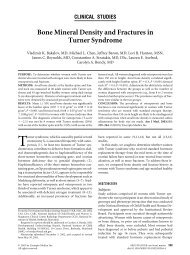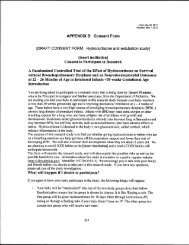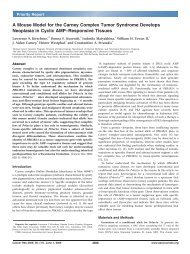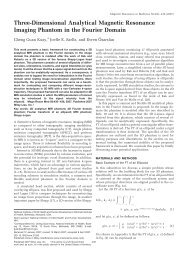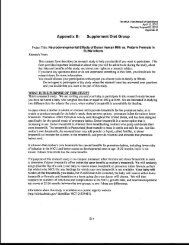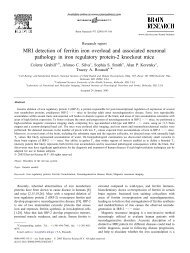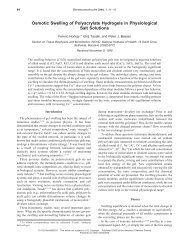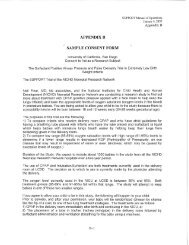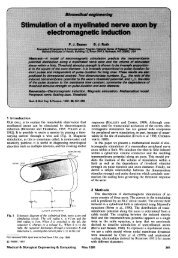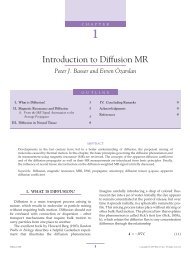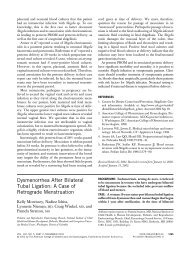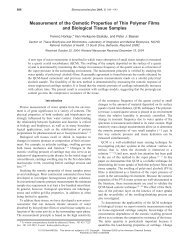The lentiginoses: cutaneous markers of systemic disease and a ...
The lentiginoses: cutaneous markers of systemic disease and a ...
The lentiginoses: cutaneous markers of systemic disease and a ...
You also want an ePaper? Increase the reach of your titles
YUMPU automatically turns print PDFs into web optimized ePapers that Google loves.
Familial <strong>lentiginoses</strong><br />
Downloaded from jmg.bmjjournals.com on 29 June 2006<br />
809<br />
33 Fossberg TM, Doskel<strong>and</strong> SO, Uel<strong>and</strong> PM. Protein kinases in human renal cell<br />
carcinoma <strong>and</strong> renal cortex. A comparison <strong>of</strong> isozyme distribution <strong>and</strong> <strong>of</strong><br />
responsiveness to adenosine 39: 59-cyclic monophosphate, Arch Biochem<br />
Biophys 1978;189:272–81.<br />
34 H<strong>and</strong>schin JC, Eppenberger U. Altered cellular ratio <strong>of</strong> type I <strong>and</strong> type II<br />
cyclic AMP-dependent protein kinase in human mammary tumors. FEBS Lett<br />
1979;106:301–4.<br />
35 Nakajima F, Imashuku S, Wilimas J, Champion JE, Green AA. Distribution<br />
<strong>and</strong> properties <strong>of</strong> type I <strong>and</strong> type II binding proteins in the cyclic adenosine<br />
39:59-monophosphate-dependent protein kinase system in Wilms’ tumor.<br />
Cancer Res 1984;44:5182–7.<br />
36 Watson DM, Hawkins RA, Bundred NJ, Stewart HJ, Miller WR. Tumor cyclic<br />
AMP binding proteins <strong>and</strong> endocrine responsiveness in patients with<br />
inoperable breast cancer. Br J Cancer 1987;56:141–2.<br />
37 Piroli G, Weisenberg LS, Grillo C, De Nicola AF. Subcellular distribution <strong>of</strong><br />
cyclic adenosine 39:59-monophosphate-binding protein <strong>and</strong> estrogen<br />
receptors in control pituitaries <strong>and</strong> estrogen-induced pituitary tumors. J Natl<br />
Cancer Inst 1990;82:596–601.<br />
38 Bradbury AW, Carter DC, Miller WR, Cho-Chung YS, Clair T. Protein kinase<br />
A (PKA) regulatory subunit expression in colorectal cancer <strong>and</strong> related<br />
mucosa. Br J Cancer 1994;69:738–42.<br />
39 McDaid HM, Cairns MT, Atkinson RJ, McAleer S, Harkin DP, Gilmore P,<br />
Johnston PG. Increased expression <strong>of</strong> the RIalpha subunit <strong>of</strong> the cAMPdependent<br />
protein kinase A is associated with advanced stage ovarian<br />
cancer. Br J Cancer 1999;79:933–9.<br />
40 Bossis I, Stratakis CA. PRKAR1A: normal <strong>and</strong> abnormal functions.<br />
Endocrinology 2004;145:5452–8.<br />
41 Casey M, Vaughan CJ, He J, Hatcher CJ, Winter JM, Weremowicz S,<br />
Montgomery K, Kucherlapati R, Morton CC, Basson CT. Mutations in the<br />
protein kinase A R1alpha regulatory subunit cause familial cardiac myxomas<br />
<strong>and</strong> Carney complex. J Clin Invest 2000;106:31–8.<br />
42 Robinson-White A, Hundley TR, Shiferaw M, Bertherat J, S<strong>and</strong>rini F,<br />
Stratakis CA. Protein kinase A activity in PRKAR1A-mutant cells <strong>and</strong><br />
regulation <strong>of</strong> mitogen-activated protein kinases ERK1/2. Hum Mol Genet<br />
2003;12:1475–84.<br />
43 Tsilou ET, Chan CC, S<strong>and</strong>rini F, Rubin BI, de Shen F, Carney JA, Kaiser-<br />
Kupfer M, Stratakis CA. Eyelid myxoma in Carney complex without<br />
PRKAR1A allelic loss. Am J Med Genet 2004;130A:395–7.<br />
44 Amieux PS, Cummings DE, Motamed K, Br<strong>and</strong>on EP, Wailes LA, Le K,<br />
Idzerda RL, McKnight GS. Compensatory regulation <strong>of</strong> RIalpha protein levels<br />
in protein kinase A mutant mice. J Biol Chem 1997;272:3993–8.<br />
45 Griffin KJ, Kirschner LS, Matyakhina L, Stergiopoulos S, Robinson-White A,<br />
Lenherr S, Weinberg FD, Claflin E, Meoli E, Cho-Chung YS, Stratakis CA.<br />
Down-regulation <strong>of</strong> regulatory subunit type 1A <strong>of</strong> protein kinase A leads to<br />
endocrine <strong>and</strong> other tumors. Cancer Res 2004;64:8811–5.<br />
46 Griffin KJ, Kirschner LS, Matyakhina L, Stergiopoulos S, Robinson-White A,<br />
Lenherr S, Weinberg F, Claflin E, Batista D, Bourdeau I, Voutetakis A,<br />
S<strong>and</strong>rini F, Meoli E, Bauer A, Cho-Chung YS, Bornstein SR, Carney JA,<br />
Stratakis CA. A transgenic mouse bearing an antisense construct <strong>of</strong><br />
regulatory subunit type 1A <strong>of</strong> protein kinase A develops endocrine <strong>and</strong> other<br />
tumors: comparison to Carney complex <strong>and</strong> other PRKAR1A-induced lesions.<br />
J Med Genet 2004;41:923–31.<br />
47 Bourdeau I, Lacroix A, Schurch W, Caron P, Antakly T, Stratakis CA.<br />
Primary pigmented nodular adrenocortical <strong>disease</strong>: paradoxical responses<br />
<strong>of</strong> cortisol secretion to dexamethasone occur in vitro <strong>and</strong> are associated with<br />
increased expression <strong>of</strong> the glucocorticoid receptor. J Clin Endocrinol Metab<br />
2003;88:3931–7.<br />
48 Cho YS, Kim MK, Cheadle C, Neary C, Becker KG, Cho-Chung YS.<br />
Antisense DNAs as multisite genomic modulators identified by DNA<br />
microarray. Proc Natl Acad Sci U S A, 2001;98:9819–23.<br />
49 Veugelers M, Wilkes D, Burton K, McDermott DA, Song Y, Goldstein MM, La<br />
Perle K, Vaughan CJ, O’Hagan A, Bennett KR, Meyer BJ, Legius E,<br />
Karttunen M, Norio R, Kaariainen H, Lavyne M, Neau JP, Richter G, Kirali K,<br />
Farnsworth A, Stapleton K, Morelli P, Takanashi Y, Bamforth JS, Eitelberger F,<br />
Noszian I, Manfroi W, Powers J, Mochizuki Y, Imai T, Ko GT, Driscoll DA,<br />
Goldmuntz E, Edelberg JM, Collins A, Eccles D, Irvine AD, McKnight GS,<br />
Basson CT. Comparative PRKAR1A genotype-phenotype analyses in humans<br />
with Carney complex <strong>and</strong> prkar1a haploinsufficient mice. Proc Natl Acad<br />
Sci U S A 2004;101:14222–7.<br />
50 Gorlin RJ, Anderson RC, Blaw M. Multiple lentigines syndrome. Am J Dis<br />
Child 1969;117:652–62.<br />
51 Voron DA, Hatfield HH, Kalkh<strong>of</strong>f RK. Multiple lentigines syndrome: case<br />
report <strong>and</strong> review <strong>of</strong> the literature. Am J Med 1976;60:447–56.<br />
52 Chong WS, Klanwarin W, Giam YC. Generalized <strong>lentiginoses</strong> in two<br />
children lacking <strong>systemic</strong> associations: case report <strong>and</strong> review <strong>of</strong> the<br />
literature. Pediatr Dermatol 2004;21:139–45.<br />
53 Abdelmalek NF, Gerber TL, Menter A. Cardio<strong>cutaneous</strong> syndromes <strong>and</strong><br />
associations. J Am Acad Dermatol 2002;46:161–83.<br />
54 Woywodt A, Welzel J, Haase H, Duerholz A, Wieg<strong>and</strong> U, Potratz J,<br />
Sheikhzadeh A. Cardiomyopathic lentiginosis/LEOPARD Syndrome<br />
presenting as sudden cardiac arrest. Chest 1998;113:1415–17.<br />
55 Yagubyan M, Panneton J, Lindor NM, Conti E, Sarkozy A, Pizzuti A.<br />
LEOPARD syndrome: a new polyaneurysm association <strong>and</strong> an update on the<br />
molecular genetics <strong>of</strong> the <strong>disease</strong>. J Vasc Surg 2004;39:897–900.<br />
56 Schievink WI, Michels VV, Mokri B, Piepgras DG, Perry HO. A familial<br />
syndrome <strong>of</strong> arterial dissections with lentiginosis. N Engl J Med<br />
1995;332:576–9.<br />
57 Allanson JE. Noonan syndrome. J Med Genet 1987;24:9–13.<br />
58 Tartaglia M, Mehler EL, Goldberg R, Zampino G, Brunner HG, Kremer H,<br />
Van der Burgt I, Crosby AH, Ion A, Kalidas JS, Patton MA, Kucherlapati RS,<br />
Gelb BD. Mutations in PTPN11, encoding the protein tyrosine phosphatase<br />
SHP-2, cause Noonan syndrome. Nat Genet 1996;29:465–8.<br />
59 Digilio MC, Conti E, Sarkozy A, Mingarelli R, Dottorini T, Marino B, Pizzuti A,<br />
Dallapiccola B. Grouping <strong>of</strong> multiple-lentigines/LEOPARD <strong>and</strong> Noonan<br />
syndrome on the PTPN11 gene. Am J Hum Genet 2002;71:189–94.<br />
60 Legius E, Schr<strong>and</strong>er-Stumpel C, Schollen E, Pulles-Heintzberger C,<br />
Gewillig M, Fryns JP. PTPN11 mutations in LEOPARD syndrome. J Med<br />
Genet 2002;39:571–4.<br />
61 Neel BG, Gu H, Pao L. <strong>The</strong> ‘Shp’ing news: SH2 domain-containing tyrosine<br />
phosphatases in cell signaling. Trends Biochem Sci 2003;28:284–93.<br />
62 Loh ML, Vattikuti S, Schubbert S, Reynolds MG, Carlson E, Lieuw KH,<br />
Cheng JW, Lee CM, Stokoe D, Bonifas JM, Curtiss NP, Gotlib J, Meshinchi S,<br />
LeBeau MM, Emanuel PD, Shannon KM. Mutations in PTPN11 implicate the<br />
SHP-2 phosphatase in leukemogenesis. Blood 2004;103:2325–31.<br />
63 Sarkozy A, Conti E, Seripa D, Digilio MC, Grifone N, T<strong>and</strong>oi C, Fazio VM,<br />
Di Ciommo V, Marino B, Pizzuti A, Dallapiccola B. Correlation between<br />
PTPN11 gene mutations <strong>and</strong> congenital heart defects in Noonan <strong>and</strong><br />
LEOPARD syndromes. J Med Genet 2003;40:704–8.<br />
64 Tartaglia M, Niemeyer CM, Fragale A, Song X, Buechner J, Jung A,<br />
Hahlen K, Hasle H, Licht JD, Gelb BD. Somatic mutations in PTPN11 in<br />
juvenile myelomonocytic leukemia, myelodysplastic syndromes <strong>and</strong> acute<br />
myeloid leukemia. Nat Genet 2003;34:148–50.<br />
65 Araki T, Mohi MG, Ismat FA, Bronson RT, Williams IR, Kutok JL, Yang W,<br />
Pao LI, Gillil<strong>and</strong> DG, Epstein JA, Neel BG. Mouse model <strong>of</strong> Noonan<br />
syndrome reveals cell type- <strong>and</strong> gene dosage-dependent effects <strong>of</strong> Ptpn11<br />
mutation. Nat Med 2004;10:849–57.<br />
66 Amos CI, Keitheri-Cheteri MB, Sabripour M, Wei C, McGarrity TJ, Seldin MF,<br />
Nations L, Lynch PM, Fidder HH, Friedman E, Frazier ML. Genotypephenotype<br />
correlations in Peutz-Jeghers syndrome. J Med Genet<br />
2004;41:327–33.<br />
67 Giardiello FM, Brensinger JD, Tersmette AC, Goodman SN, Petersen GM,<br />
Booker SV, Cruz-Correa M, Offerhaus JA. Very high risk <strong>of</strong> cancer in familial<br />
Peutz-Jeghers syndrome. Gasteroenterology 2000;119:1447–53.<br />
68 Stratakis CA, Kirschner LS, Taymans SE, Tomlinson IP, Marsh DJ, Torpy DJ,<br />
Giatzakis C, Eccles DM, <strong>The</strong>aker J, Houlston RS, Blouin JL, Antonarakis SE,<br />
Basson CT, Eng C, Carney JA. Carney complex, Peutz-Jeghers syndrome,<br />
Cowden <strong>disease</strong>, <strong>and</strong> Bannayan-Zonana syndrome share <strong>cutaneous</strong> <strong>and</strong><br />
endocrine manifestations, but not genetic loci. J Clin Endocrinol Metab<br />
1998;83:2972–6.<br />
69 Lim W, Olschwang S, Keller JJ, Westerman AM, Menko FH, Boardman LA,<br />
Scott RJ, Trimbath J, Giardiello FM, Gruber SB, Gille JJ, Offerhaus GJ, de<br />
Rooij FW, Wilson JH, Spigelman AD, Phillips RK, Houlston RS. Relative<br />
frequency <strong>and</strong> morphology <strong>of</strong> cancers in STK11 mutation carriers.<br />
Gastroenterology 2004;126:1788–94.<br />
70 Hemminki A, Markie D, Tomlinson I, Avizienyte E, Roth S, Loukola A,<br />
Bignell G, Warren W, Amin<strong>of</strong>f M, Hoglund P, Jarvinen H, Kristo P, Pelin K,<br />
Ridanpaa M, Salovaara R, Toro T, Bodmer W, Olschwang S, Olsen AS,<br />
Stratton MR, de la Chapelle A, Aaltonen LA. A serine/threonine kinase gene<br />
defective in Peutz-Jeghers syndrome. Nature 1998;391:184–7.<br />
71 Jenne DE, Reimann H, Nezu J, Friedel W, L<strong>of</strong>f S, Jeschke R, Muller O,<br />
Back W, Zimmer M. Peutz-Jeghers syndrome is caused by mutations in a<br />
novel serine threonine kinase. Nat Genet 1998;18:38–43.<br />
72 Hearle N, Lucassen A, Wang R, Lim W, Ross F, Wheeler R, Moore I,<br />
Shipley J, Houlston R. Mapping <strong>of</strong> a translocation breakpoint in a Peutz-<br />
Jeghers hamartoma to the putative PJS locus at 19q13.4 <strong>and</strong> mutation<br />
analysis <strong>of</strong> c<strong>and</strong>idate genes in polyp <strong>and</strong> STK11-negative PJS cases. Genes<br />
Chromosomes Cancer 2004;41:163–9.<br />
73 Boardman LA, Couch FJ, Burgart LJ, Schwartz D, Berry R, McDonnell SK,<br />
Schaid DJ, Hartmann LC, Schroeder JJ, Stratakis CA, Thibodeau SN. Genetic<br />
heterogeneity in Peutz-Jeghers syndrome. Hum Mutat 2000;16:23–30.<br />
74 Spicer J, Ashworth A. LKB1 kinase: master <strong>and</strong> comm<strong>and</strong>er <strong>of</strong> metabolism<br />
<strong>and</strong> polarity. Curr Biol 2004;25:R383–5.<br />
75 Shaw RJ, Bardeesy N, Manning BD, Lopez L, Kosmatka M, DePinho RA,<br />
Cantley LC. <strong>The</strong> LKB1 tumor suppressor negatively regulates mTOR signaling.<br />
Cancer Cell 2004;6:91–9.<br />
76 Nelson WJ. Cell biology: a cellular choreographer. Nature 2004;428:28–9.<br />
77 Baas AF, Kuipers J, van der Wel NN, Batlle E, Koerten HK, Peters PJ,<br />
Clevers HC. Complete polarization <strong>of</strong> single intestinal epithelial cells upon<br />
activation <strong>of</strong> LKB1 by STRAD. Cell 2004;116:457–66.<br />
78 Shaw RJ, Bardeesy N, Manning BD, Lopez L, Kosmatka M, DePinho RA,<br />
Cantley LC. <strong>The</strong> LKB1 tumor suppressor negatively regulates mTOR signaling.<br />
Cancer Cell 2004;6:91–9.<br />
79 Manning BD, Cantley LC. United at last: the tuberous sclerosis complex gene<br />
products connect the phosphoinositide 3-kinase/Akt pathway to mammalian<br />
target <strong>of</strong> rapamycin (mTOR) signaling. Biochem Soc Trans 2003;31(pt<br />
3):573–7.<br />
80 Fingar DC, Blenis J. Target <strong>of</strong> rapamycin (TOR): an integrator <strong>of</strong> nutrient <strong>and</strong><br />
growth factor signals <strong>and</strong> coordinator <strong>of</strong> cell growth <strong>and</strong> cell cycle<br />
progression. Oncogene 2004;23:3151–71.<br />
81 Shaw RJ, Kosmatka M, Bardeesy N, Hurley RL, Witters LA, DePinho RA,<br />
Cantley LC. <strong>The</strong> tumor suppressor LKB1 kinase directly activates AMPactivated<br />
kinase <strong>and</strong> regulates apoptosis in response to energy stress. Proc<br />
Natl Acad Sci U S A 2004;101:3329–35.<br />
82 Inoki K, Zhu T, Guan LK. TSC2 mediates cellular energy response to control<br />
cell growth <strong>and</strong> survival. Cell 2003;115:577–90.<br />
83 Brugarolas J, Kaelin WG. Dysregulation <strong>of</strong> HIF <strong>and</strong> VEGF is a unifying<br />
feature <strong>of</strong> the familial hamartoma syndromes. Cancer Cell 2004;6:7–10.<br />
84 Bardeesy N, Sinha M, Hezel AF, Signoretti S, Hathaway NA, Sharpless NE,<br />
Loda M, Carrasco DR, DePinho RA. Loss <strong>of</strong> the Lkb1 tumour suppressor<br />
provokes intestinal polyposis but resistance to transformation. Nature<br />
2002;419:162–7.<br />
www.jmedgenet.com



